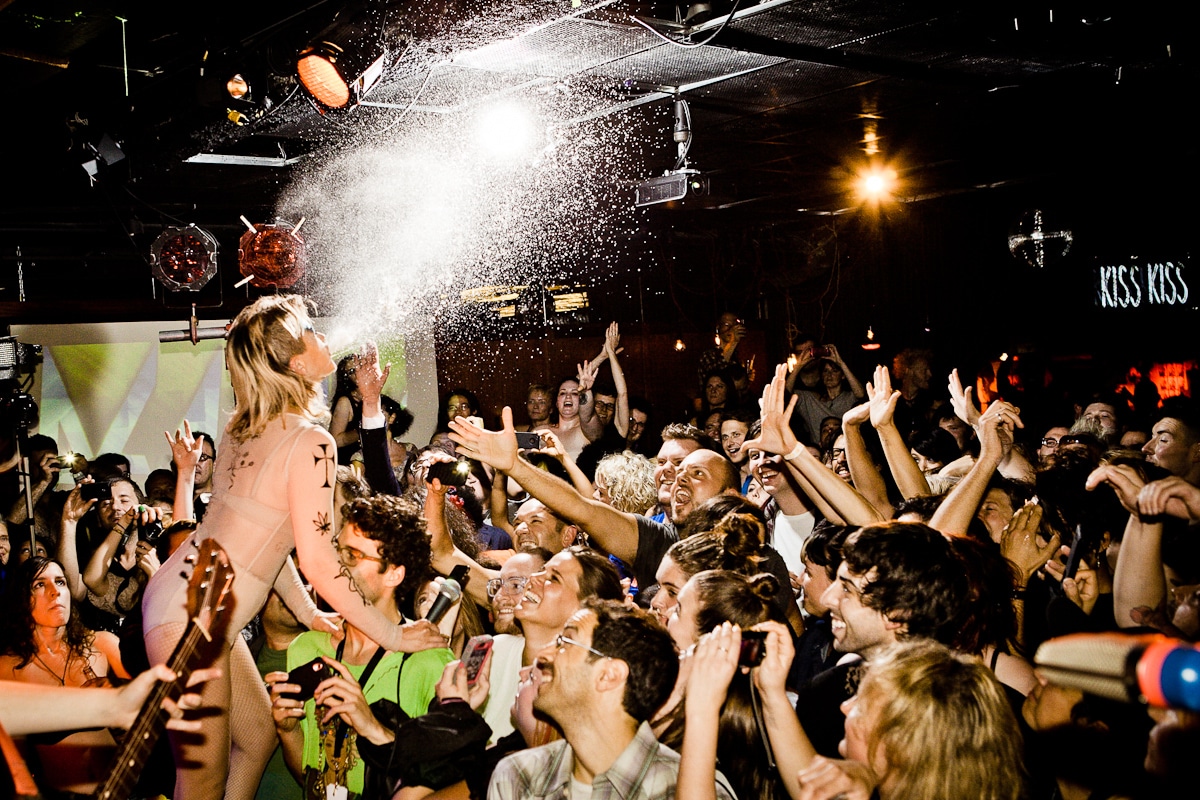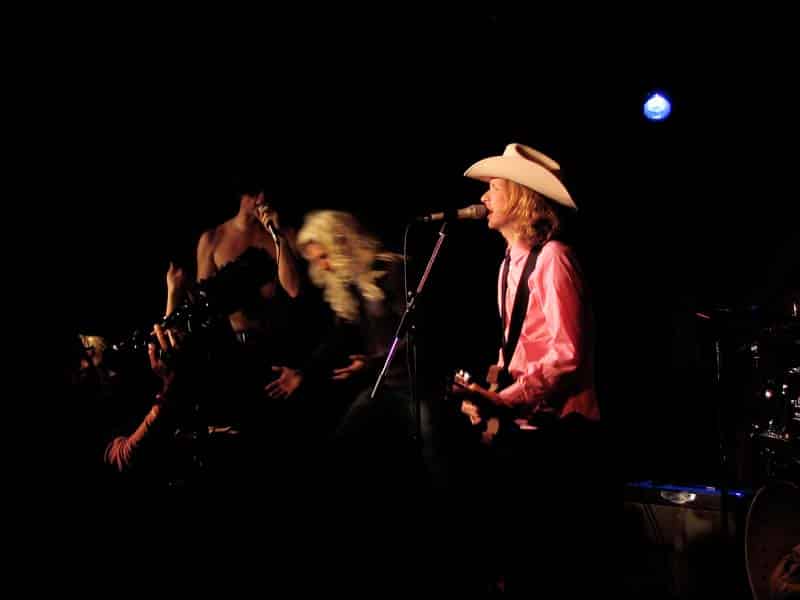THE NEW POLLUTION: Beck, shown during a surprise gig at the historic Drake Underground in Toronto, in 2006. (Courtesy Venue)
In Toronto, there was a Drake before the Drake. The boutique hotel, which opened in 1890 as Small’s Hotel, was renamed The Drake in 1949. The area, at the time, on Queen Street West, bordering on the city’s Parkdale neighborhood, was run down and not the hotspot it is today with 51 hotel rooms and a 150-capacity venue in its basement called the Drake Underground. That space has hosted shows by Billie Eilish, Beck, Leon Bridges, Martha Wainwright, Slowdive’s Neil Halstead, Brent Faiyaz, and Toronto’s Metric, Peaches, Broken Social Scene, and Skratch Bastid — in all, an estimated 4,000 shows, about 200 a year, to this day.
Jeff Stober bought the property in 2001 for $639,000 with a vision to develop it into a kind of New York-style Hotel Chelsea for creatives. After putting a reported $6 million into it, it opened Feb. 14, 2004, even better than he had envisioned, a combo hotel, art space, elevated cuisine, and live music.
Ana Yuristy, who started at The Drake in 2007 as hotel manager and now has the unique title of chief people and brand officer, has worked over the years in the company with almost every department, including IT, security, and programming (they now have another hotel in Prince Edward County). It was a time when it “felt like it was a bit of a trek to the west part of the city from the downtown core,” she said, referring to the area as West Queen West. “It didn’t feel as safe walking around at night in those early days, as one would now where it’s a thriving nightlife community with tons of great restaurants.”
She has seen eight music programmers come and go in the Underground’s eight years, the last, Chris Wilson, who programmed virtual shows through COVID, to Jalyssa Mills, who joined the company last August.
“Every one of the programmers has put a unique spin on talent that they are outreaching to,” Yuristy said. “So, whether it’s an up and coming collective or, back in the day, more of an indie flavor, everyone has put a unique spin on that and Jalyssa is no exception. That is what has been evolving and changing, tapping into the moment and what’s coming up next, which is, for a guest, really exciting. You’re very likely to experience a show in the Underground that in five years everyone will be talking about. It’s artists who are at that really interesting cusp in their careers, with some big names that are peppered in as well.
“Some elements have remained consistent,” she adds. “Because it’s a 150-person venue, it’s a really intimate place to see a show. The ownership has really invested in upgrading the space, our AV system, our lighting. The people that manage our AV team really care about the show being successful from that point of view, which makes it a really appealing destination for bands, promoters and the different artists that are coming through the city. It has a reputation for being a premier venue and a good place to play.”
In 2018, the Drake Underground underwent a full renovation, which included new speakers and lighting (following a flood that August). A new green room was added in late 2021, alongside the renovation and opening of the Drake modern wing. Then, in 2022, they brought in a new SD-12 AV mixing console. They have an Onyx lighting program, Digico SD-12 mixer (moving from analog to digital) and Pioneer CDJ 3000.

Toronto’s Peaches pictured at The Underground at the The Drake hotel, which holds 150 people. (Courtesy venue)
The in-house engineer is Davin Veerasmy “who we still work with in a freelance capacity, however this role is currently open and the department is being overseen by our director of IT, Richardo Mighty,” Yuristy said. Currently, there are nine techs on the roster, including two from the non-profit arts training program The Remix Project.
The marquee names usually come through label showcases or major promoters. A newly signed Preston Pablo (31 East/Universal Music Canada) showcased there last March. In February 2018, Live Nation had Faiyaz there; last month, he played the 2,500-capacity History. Eilish was just 15 when she played there, her first show in Toronto. Beck’s appearance was an after-party, following one of his major shows, and Peaches, already playing sizable venues, came through The Drake’s art and curatorial team.
But other acts have been booked by their ear-to-the-ground music programmers, such as Skratch Bastid, Itzsoweezee, and Wainwright by Jeff Rogers, Halstead by Jeff Van Harmelen, and Bridges by Nate Stein. “Nate was adamant that he was gonna be big,” Yuristy said. “I didn’t stick around for the show and it is one of my regrets.”
Mills, only six months in the job, says her vision is to “connect with culture and put our venue on the map for being a tastemaker and being ahead of the curve when it comes to programming and sourcing international and local emerging talent.
“That’s something that The Drake has always been known for and has always excited me and drawn me to the space. And I want to continue that legacy and create new programs that are a little out of the box that allow those opportunities to happen.”
Booked six to eight months in advance, Mills says the calendar is booked through the end of the year with isolated dates available.
“Our venue is unique in that we work with a lot of partner promoters,” she said. “So as a talent buyer, I focus mainly on the DJ and late-night booking. As a programmer, for our holds in the calendar, we work a lot with our partners so Live Nation, Embrace, RapSeason, and they bring the events to us and they’re having the background conversations with the agents. As far as the late-night DJ program, we do the outreach for their budding DJs or even more developed DJs.”
School Night, the last Monday of every month, showcases emerging talent, who don’t have management, agents of label representation. “A lot of those artists are at the cusp of getting signed,” says Mills. “Their music is strong; their talent is strong; their social engagement is all the way there and we give them that platform and invite the agents and other bookers, as well as labels to come down. Artists have gotten signed from this program.”
For the 20th anniversary, The Underground will have a show by Juno-nominated, Polaris Music Prize short-listed artist Begonia, the night her documentary, Powder Blue, Live at Club Regent, screens at Hot Docs Feb. 23. The night is being billed as the West Queen West Throwback House Party, featuring Broken Social Scene’s Brendan Canning hosting “an open-format indie showcase” with performances by members of BSS, Zeus, Apostle of Hustle, Controller.Controller, Stars, and more.
There is also a programmer panel, Feb. 13, moderated by Mills, who will “explore the evolution of the Underground’s impact on the city’s music scene,” according to the description.
So, what is the impact?
“It is a starting point and jump-off point for a lot of artists and their careers, whether they’re local or international,” says Mills. “We are unique in that we are one of the only venues with that capacity so for small up and coming artists, for showcasing artists, for open-mic nights, for comedy, for every art form under the sun. We’re unique because of that.”







